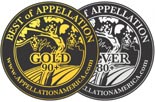

The New Future of Iowa Grape Growing and Winemaking
by
Tim Pingelton
March 19, 2009
Iowa was one of the largest wine producers in the country at one time, and then Prohibition put us out of business. The next thing that happened was the 1940 Armistice Day Storm that killed every apple tree and grape vine in Iowa. Now Iowa is experiencing a new era for grape growing and winemaking: the people are different, the grapes are different, and production and marketing are different.
[>] see full story

 Famous as a "corn state", Iowa has focused on growing wine grapes in recent years. Acreage under vine is increasing rapidly, with nearly 60 wineries now licensed in the state. Iowa’s soils vary greatly, from those very high in clay, to soils that are gravel based. The areas showing the greatest potential for vines are in the westward “Loess Hills” area and in the northeast, with its magnificent limestone-based soils and steep slopes that stretch over about 20 miles.
Famous as a "corn state", Iowa has focused on growing wine grapes in recent years. Acreage under vine is increasing rapidly, with nearly 60 wineries now licensed in the state. Iowa’s soils vary greatly, from those very high in clay, to soils that are gravel based. The areas showing the greatest potential for vines are in the westward “Loess Hills” area and in the northeast, with its magnificent limestone-based soils and steep slopes that stretch over about 20 miles.
Despite all of its strengths, Iowa does have challenges. The state is trying to overcome the devastating effects of 2,4-D, a herbicide which is still commonly used and is extremely lethal to grapes. Iowa also has four very distinct and extreme seasons. Hot summer days make grapes susceptible to fungal disease, and in the winter -20 F days are not uncommon. Hardy cultivars are a must in this region. There are few vinifera varieties grown in the state, however much work is done with French Hybrids and native American grapes. Iowa is going through an experimental period, with all the determination and potential needed to succeed.
|
|
Current Feature
In the southern Blue Ridge Mountains of North Carolina and Georgia vineyards are small and few, yet the establishment of the Upper Hiwassee Highlands could bring much more.
[>] continue
Related Features
Best of Appellation
See the best wines of
Iowa
BLUE BOOK PROFILES
Blue Book Taste Profiles for the Iowa State Appellation
Alive & Well here

Marechal Foch:
Who is this little French hybrid chap that has become so popular in the Midwest and on the eastern seaboard?
[>] continue





 Bi-State Upper Hiwassee Highlands an AVA
Bi-State Upper Hiwassee Highlands an AVA  Remote Manton Valley New California AVA
Remote Manton Valley New California AVA WAWGG Banquet Explores Washington State Terrior
WAWGG Banquet Explores Washington State Terrior Taking Focus on Appellation
Taking Focus on Appellation Whitehall Lane Winery, A 20 Year Story of Vineyards
Whitehall Lane Winery, A 20 Year Story of Vineyards Embracing Virginia’s Terroir
Embracing Virginia’s Terroir  Appellation America to Drop Paywall - Provide Open Access
Appellation America to Drop Paywall - Provide Open Access Shake Ridge Ranch - Gem of the Sierra
Shake Ridge Ranch - Gem of the Sierra Tannat, Vibrant Across the America's
Tannat, Vibrant Across the America's
